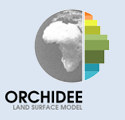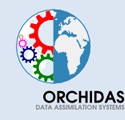Land Surface Model ORCHIDEE

ORCHIDEE is a global process-oriented Terrestrial Biosphere Model [Krinner et al., 2005]. It calculates carbon, water and energy fluxes between land surfaces and the atmosphere. The water and energy component computes major biophysical variables (albedo, roughness height, soil humidity) and solves the energy and hydrological balances at a half-hourly time step. The carbon module describes photosynthesis and respiration at the same temporal resolution; the slow components of the terrestrial carbon cycle (including LAI, carbon allocation in plant reservoirs, soil carbon dynamics, and litter decomposition) are calculated on a daily basis. A turnover rate is applied to biomass pools and produces litterfall. Litter is decomposed and goes into three soil organic carbon pools with different residence times (active, slow and passive) following the CENTURY model [Parton et al., 1988]. The link between the water and carbon modules is done through photosynthesis, which is based on the work of Farquhar et al. [1980] for C3 plants and Collatz et al. [1992] for C4 plants. The stomatal conductance is based on Ball et al. [1987]. The carbon module first calculates LAI and the water and energy module then calculates GPP and stomatal conductance. The carbon module calculates growth and maintenance respirations [Ruimy et al., 1996] and Net Primary Production (NPP), heterotrophic respiration and Net Ecosystem Exchange (NEE). ORCHIDEE is the land surface component of the IPSL-CM5 Earth System Model (Dufresne et al., submitted), currently used for CMIP5 simulations.







